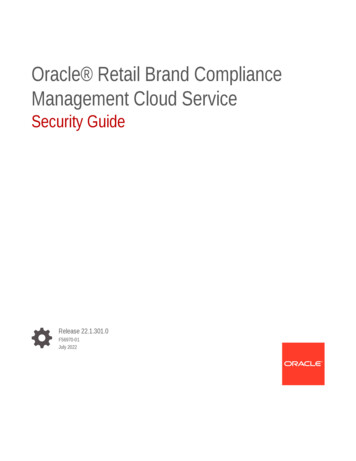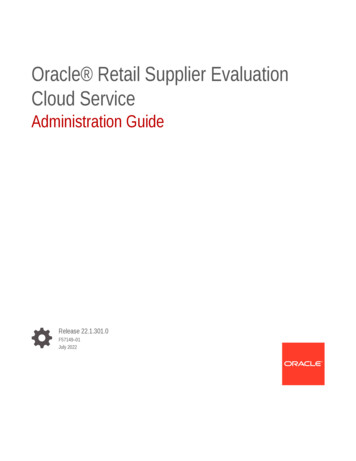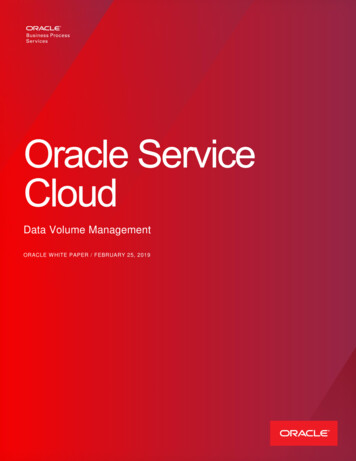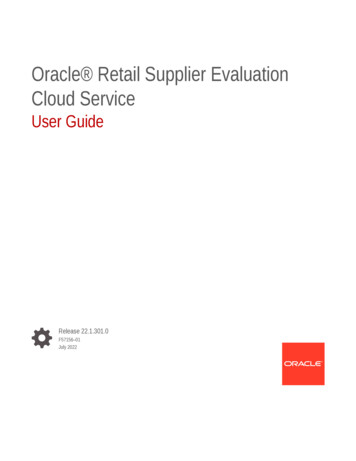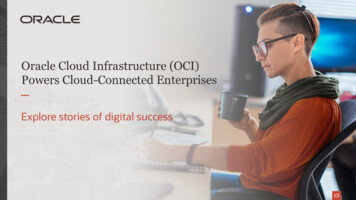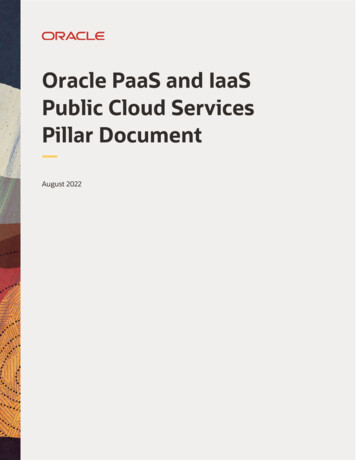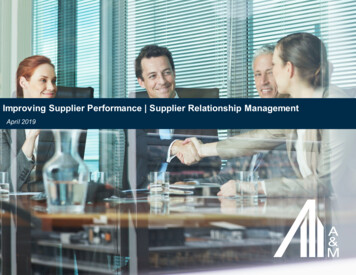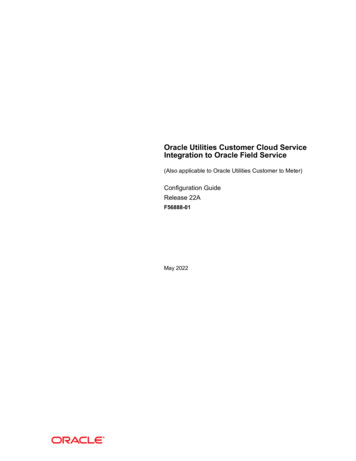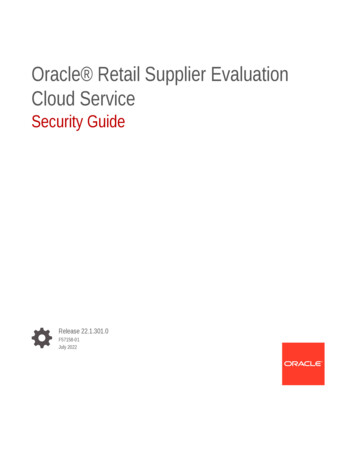
Transcription
Oracle Retail Supplier EvaluationCloud ServiceSecurity GuideRelease 22.1.301.0F57158-01July 2022
Oracle Retail Supplier Evaluation Cloud Service Security Guide, Release 22.1.301.0F57158-01Copyright 2022, Oracle and/or its affiliates.Primary Author: Bernadette GoodmanContributing Authors: Aidan RatcliffeThis software and related documentation are provided under a license agreement containing restrictions onuse and disclosure and are protected by intellectual property laws. Except as expressly permitted in yourlicense agreement or allowed by law, you may not use, copy, reproduce, translate, broadcast, modify, license,transmit, distribute, exhibit, perform, publish, or display any part, in any form, or by any means. Reverseengineering, disassembly, or decompilation of this software, unless required by law for interoperability, isprohibited.The information contained herein is subject to change without notice and is not warranted to be error-free. Ifyou find any errors, please report them to us in writing.If this is software or related documentation that is delivered to the U.S. Government or anyone licensing it onbehalf of the U.S. Government, then the following notice is applicable:U.S. GOVERNMENT END USERS: Oracle programs (including any operating system, integrated software,any programs embedded, installed or activated on delivered hardware, and modifications of such programs)and Oracle computer documentation or other Oracle data delivered to or accessed by U.S. Government endusers are "commercial computer software" or "commercial computer software documentation" pursuant to theapplicable Federal Acquisition Regulation and agency-specific supplemental regulations. As such, the use,reproduction, duplication, release, display, disclosure, modification, preparation of derivative works, and/oradaptation of i) Oracle programs (including any operating system, integrated software, any programsembedded, installed or activated on delivered hardware, and modifications of such programs), ii) Oraclecomputer documentation and/or iii) other Oracle data, is subject to the rights and limitations specified in thelicense contained in the applicable contract. The terms governing the U.S. Government’s use of Oracle cloudservices are defined by the applicable contract for such services. No other rights are granted to the U.S.Government.This software or hardware is developed for general use in a variety of information management applications.It is not developed or intended for use in any inherently dangerous applications, including applications thatmay create a risk of personal injury. If you use this software or hardware in dangerous applications, then youshall be responsible to take all appropriate fail-safe, backup, redundancy, and other measures to ensure itssafe use. Oracle Corporation and its affiliates disclaim any liability for any damages caused by use of thissoftware or hardware in dangerous applications.Oracle, Java, and MySQL are registered trademarks of Oracle and/or its affiliates. Other names may betrademarks of their respective owners.Intel and Intel Inside are trademarks or registered trademarks of Intel Corporation. All SPARC trademarks areused under license and are trademarks or registered trademarks of SPARC International, Inc. AMD, Epyc,and the AMD logo are trademarks or registered trademarks of Advanced Micro Devices. UNIX is a registeredtrademark of The Open Group.This software or hardware and documentation may provide access to or information about content, products,and services from third parties. Oracle Corporation and its affiliates are not responsible for and expresslydisclaim all warranties of any kind with respect to third-party content, products, and services unless otherwiseset forth in an applicable agreement between you and Oracle. Oracle Corporation and its affiliates will not beresponsible for any loss, costs, or damages incurred due to your access to or use of third-party content,products, or services, except as set forth in an applicable agreement between you and Oracle.
ContentsSend Us Your CommentsPrefaceAudienceviDocumentation AccessibilityviRelated DocumentsviImproved Process for Oracle Retail Documentation CorrectionsviiOracle Retail Documentation on the Oracle Help Center sponsibilities34Retailer/Portal Owner Responsibilities2-1Oracle Responsibilities2-1Oracle Retail SaaS SecuritySecure Product Engineering3-1Secure Deployment3-1Physical Safeguards3-1Network Security3-2Infrastructure Security3-2Data Security3-2Secure Management3-2Assessment and Audit3-3Supplier Evaluation Cloud Service ArchitectureArchitecture Overview4-1iii
Access Flow564-1Supplier Evaluation Cloud Service Authentication and AuthorizationAuthentication and IDCS or OCI IAM5-1IDCS and OCI IAM5-1IDCS, OCI IAM, and Application Users5-2Authorization5-2Supplier Evaluation Cloud Service PermissionsRoles6-2Roles Provided at Initial Setup6-2Authority Profiles6-3Permissions6-47Frequently Asked QuestionsAAppendix: RolesBAppendix: Authority ProfilesCAppendix: Authority Profile GroupsDAppendix: Authority Profile to Role Mappingsiv
Send Us Your CommentsOracle Retail Supplier Evaluation Cloud Service Security Guide, Release 22.1.301.0Oracle welcomes customers' comments and suggestions on the quality and usefulness of thisdocument.Your feedback is important, and helps us to best meet your needs as a user of our products.For example: Are the implementation steps correct and complete? Did you understand the context of the procedures? Did you find any errors in the information? Does the structure of the information help you with your tasks? Do you need different information or graphics? If so, where, and in what format? Are the examples correct? Do you need more examples?If you find any errors or have any other suggestions for improvement, then please tell us yourname, the name of the company who has licensed our products, the title and part number ofthe documentation and the chapter, section, and page number (if available).Note:Before sending us your comments, you might like to check that you have the latestversion of the document and if any concerns are already addressed. To do this,access the Online Documentation available on the Oracle Help Center(docs.oracle.com) web site. It contains the most current Documentation Library plusall documents revised or released recently.Send your comments to us using the electronic mail address: retail-doc us@oracle.comPlease give your name, address, electronic mail address, and telephone number (optional).If you need assistance with Oracle software, then please contact your support representativeor Oracle Support Services.If you require training or instruction in using Oracle software, then please contact your Oraclelocal office and inquire about our Oracle University offerings. A list of Oracle offices isavailable on our web site at http://www.oracle.com.v
PrefacePrefaceThis document serves as a guide for administrators, developers, and systemintegrators who securely administer, customize, and integrate the Oracle RetailSupplier Evaluation Cloud Service application.AudienceThis document is intended for administrators, developers, and system integrators whoperform the following functions: Document specific security features and configuration details for the abovementioned product, in order to facilitate and support the secure operation of theOracle Retail Product and any external compliance standards. Guide administrators, developers, and system integrators on secure productimplementation, integration, and administration.It is assumed that the readers have general knowledge of administering the underlyingtechnologies and the application.Documentation AccessibilityFor information about Oracle's commitment to accessibility, visit the OracleAccessibility Program website at http://www.oracle.com/pls/topic/lookup?ctx acc&id docacc.Access to Oracle SupportOracle customers that have purchased support have access to electronic supportthrough My Oracle Support. For information, visit http://www.oracle.com/pls/topic/lookup?ctx acc&id info or visit http://www.oracle.com/pls/topic/lookup?ctx acc&id trs if you are hearing impaired.Related DocumentsFor more information, see the following documents in the Oracle Retail SupplierEvaluation Cloud Service documentation set: Oracle Retail Supplier Evaluation Cloud Service Administration Guide Oracle Retail Supplier Evaluation Cloud Service Implementation Guide Oracle Retail Supplier Evaluation Cloud Service Release Readiness Guide Oracle Retail Supplier Evaluation Cloud Service User Guide Oracle Retail Supplier Evaluation Cloud Service Workspace User Guidevi
PrefaceFor information on the Oracle Retail Supplier Evaluation Cloud Service modules, see thefollowing documents: Oracle Retail Supplier Evaluation Cloud Service Process User Guide Oracle Retail Supplier Evaluation Cloud Service Reports User Guide Oracle Retail Supplier Evaluation Cloud Service Supplier User GuideImproved Process for Oracle Retail Documentation CorrectionsTo more quickly address critical corrections to Oracle Retail documentation content, OracleRetail documentation may be republished whenever a critical correction is needed. Forcritical corrections, the republication of an Oracle Retail document may at times not beattached to a numbered software release; instead, the Oracle Retail document will simply bereplaced on the Oracle Help Center (docs.oracle.com) Web site, or, in the case of DataModels, to the applicable My Oracle Support Documentation container where they reside.Oracle Retail documentation is available on the Oracle Help Center (docs.oracle.com) at thefollowing ndex.htmlAn updated version of the applicable Oracle Retail document is indicated by Oracle partnumber, as well as print date (month and year). An updated version uses the same partnumber, with a higher-numbered suffix. For example, part number E123456-02 is an updatedversion of an document with part number E123456-01.If a more recent version of the document is available, that version supersedes all previousversions.Oracle Retail Documentation on the Oracle Help Center(docs.oracle.com)Oracle Retail product documentation is available on the following web index.html(Data Model documents can be obtained through My Oracle Support.)ConventionsThe following text conventions are used in this document:ConventionMeaningboldfaceBoldface type indicates graphical user interface elements associated with anaction, or terms defined in text or the glossary.italicItalic type indicates book titles, emphasis, or placeholder variables for whichyou supply particular values.monospaceMonospace type indicates commands within a paragraph, URLs, code inexamples, text that appears on the screen, or text that you enter.vii
1IntroductionOracle Retail Supplier Evaluation Cloud Service is a collaborative cloud service for the onboarding and evaluation of merchandising suppliers, enabling the assessment andgovernance of ethical, environmental, safety, and quality performance. It manages theselection of suppliers against Environmental, Social, and Governance (ESG), brandstandards and governance policies, incorporating supplier self-certification survey andassessment, audit and action management, vendor performance, and incident alertnotifications.Oracle Retail Supplier Evaluation Cloud Service is composed of the following modules: Library enables the issue, receipt, and acceptance of policies, guidelines, and keyworking documents. Process supports the development of process briefs, plans, and workflow management. Supplier enables the identification, selection, and approval of suppliers. Reports provides a reporting tool for reporting across the system, using standardtemplates and custom reports.This document is divided into six main sections: Responsibilities - discusses the shared responsibility model of security. Oracle Retail SaaS Security - outlines the policies and procedures Oracle Retail uses tomeet its security responsibilities. Supplier Evaluation Architecture - details the architecture of the Supplier EvaluationCloud Service, particularly as it relates to security. Supplier Evaluation Authentication and Authorization - describes how Supplier EvaluationCloud Service performs authentication and authorization. Supplier Evaluation Permissions - describes the Supplier Evaluation Cloud Service rolebased security model of roles, authority profiles and permissions. Frequently Asked Questions - a number of specific questions related to security that arefrequently asked by prospects, customers, and implementers.The goals of this document are to: Explain the security responsibilities of Oracle and the retailer/portal owner in the SaaSmodel. Educate retailers/portal owners about Oracle's cloud security policies and controls. Describe Supplier Evaluation Cloud Services:–general architecture, particularly as it relates to security–security features Define additional steps customer IT staff must perform to communicate securely withSupplier Evaluation Cloud Service. Guide customer administrators in the actions they need to perform to:1-1
Chapter 1 –create application users–assign roles to application usersProvide answers to frequently asked questions about Supplier Evaluation CloudService security.1-2
2ResponsibilitiesAs retailers migrate to the cloud, they must consider how the cloud, and more specificallySaaS, will impact their privacy, security, and compliance efforts. As the cloud service provider,Oracle Retail works together with customers to meet cloud security objectives.Retailer/Portal Owner ResponsibilitiesAt a high level, retailers/portal owners are responsible for: Understanding Oracle's security policies. Implementing their own corporate policies by using Oracle tools. Creating and administering users by using Oracle tools. Ensuring data quality and enforcing end-user devices security controls, so that anti-virus,malware and other malicious code checks are performed on data and files beforeuploading data. Ensuring that end-user devices meet the minimum security requirements.To securely implement Supplier Evaluation Cloud Service, retailers/portal owners and theirimplementation partners should read this document to understand Oracle's security policies.This document summarizes information and contains links to many other Oracle documents.Oracle ResponsibilitiesAs the cloud service provider, at the highest level Oracle Retail is responsible for: Building secure software. Provisioning and managing secure environments. Protecting the customer’s data.Supplier Evaluation Cloud Service fulfills its responsibilities by a combination of corporatelevel development practices and cloud delivery policies. Sections in this document willdescribe this information in great detail later in this document.2-1
3Oracle Retail SaaS SecuritySecurity is a many faceted issue to address. To discuss Oracle Retail SaaS security, it helpsto define and categorize the many aspects of security. For the purposes of this document, wediscuss the following categories of SaaS security: Secure Product Engineering Secure Deployment Secure Management Assessment and AuditSecure Product EngineeringOracle builds secure software through a rigorous set of formal, always evolving securitystandards and practices known as Oracle Software Security Assurance (OSSA). OSSAencompasses every phase of the product development lifecycle.More information about OSSA can be found ices/assurance/The cornerstones of OSSA are Secure Coding Standards and Security Analysis and Testing.Secure Coding Standards include both general use cases and language specific securitypractices. More information about these practices can be found ices/assurance/development/Security Analysis and Testing includes product specific functional security testing and bothstatic and dynamic analysis of the code base. Static Analysis is performed using toolsincluding both internal Oracle tools and HP's Fortify. Dynamic Analysis focuses on APIs andendpoints, using techniques such as fuzzing to test interfaces and htmlSpecific security details of the Supplier Evaluation Cloud Service are discussed in detail laterin this document.Secure DeploymentSecure deployment refers to the security of the infrastructure used to deploy the SaaSapplication. Key issues in secure deployment include Physical Safeguards, Network Security,Infrastructure Security, and Data Security.Physical SafeguardsOracle Retail SaaS applications are deployed through Oracle Cloud Infrastructure datacenters. Access to Oracle Cloud data centers requires special authorization that is monitored3-1
Chapter 3Secure Managementand audited. The premises are monitored by CCTV, with entrances protected byphysical barriers and security guards. Governance controls are in place to minimizethe resources that are able to access systems. Physical security safeguards arefurther detailed in Oracle's Cloud Hosting and Delivery work SecurityThe Oracle Cloud network is isolated from the Oracle Corporate Network. Customerinstances are separated down to the VLAN level.Infrastructure SecurityThe security of the underlying infrastructure used to deploy Oracle Retail SaaS isregularly hardened. Critical patch updates are applied on a regular schedule. Oraclemaintains a running list of critical patch updates and security alerts. Per Oracle's CloudHosting and Delivery Policies, these updates are applied to all Oracle SaaS security/alerts-086861.htmlBefore Oracle Retail deploys code to SaaS, Oracle's Global Information Security teamperforms penetration testing on the cloud service. This penetration testing andremediation prevents software or infrastructure issues in production lData SecurityOracle Retail uses a number of strategies and policies to ensure the Retailer's data isfully secured. Data Design - Oracle Retail applications avoid storing personal data. Wherepersonal information data exists in a system, Data Minimization, Right to Access,and Right to Forget services exist to support data privacy standards. Storage - Oracle Retail applications use encrypted tablespaces to store sensitivedata. Transit - All data is encrypted in transit, Retail SaaS uses TLS for secure transportof data, as documented in Oracle's Cloud Hosting and Delivery g-delivery-policies-3089853.pdfSecure ManagementOracle Retail manages SaaS based on a well-documented set of security-focusedStandard Operating Procedures (SOPs). The SOPs provide direction and describeactivities and tasks undertaken by Oracle personnel when delivering services tocustomers. SOPs are managed centrally and are available to authorized personnelthrough Oracle's intranet on a need-to-know basis.All network devices, servers, OS, applications and databases underlying Oracle RetailCloud Services are configured and maintain auditing and logging. All logs are3-2
Chapter 3Assessment and Auditforwarded to a Security Information and Event Management (SIEM) system. The SIEM ismanaged by the Security Engineering team and is monitored 24/7 by the GBU SecurityOperations team. The SIEM is configured to alert the GBU Security Operations teamregarding any conditions deemed to be potentially suspicious, for further investigation.Access given to review logs is restricted to a subset of security administrators and securityoperations personnel only.Assessment and AuditOracle Cloud meets all ISO/IEC 27002 Codes of Practice for Information Security Controls.Third Party Audit Reports and letters of compliance for Oracle Cloud Services are periodicallypublished.3-3
4Supplier Evaluation Cloud ServiceArchitectureThe Supplier Evaluation Cloud Service application is deployed on Oracle's Global BusinessUnit Cloud Services Foundation Services. The application is deployed in a highly available,high performance, horizontally scalable architecture. Supplier Evaluation Cloud Service useseither Oracle Identity Cloud Service (IDCS) or Oracle Cloud Infrastructure Identity andAccess Management (OCI IAM) as its identity provider (IDP). Information about logical,physical and data architecture in this document focuses on how the architecture supportssecurity.Architecture OverviewMost customer access to the Supplier Evaluation Cloud Service is through the web tier. Theweb tier contains the perimeter network services that protects the Supplier Evaluationapplication from the internet at large. All traffic from the web tier continues to the Web TierSecurity Server (WTSS), which in turn uses the customer's Oracle Identity Cloud Service(IDCS) or Oracle Cloud Infrastructure Identity and Access Management (OCI IAM) tenancy toperform authentication. More information about authentication through IDCS or OCI IAM isprovided later in this document.The Supplier Evaluation application is deployed on a Kubernetes cluster. Reporting isprovided by Oracle BI Publisher which can connect to the underlying database.The underlying container DBaaS includes one pluggable database (PDB) for SupplierEvaluation. Applications are able to access the Supplier Evaluation schema on the SupplierEvaluation PDB. Transparent data encryption (TDE) is set during provisioning. Tablespacesthat contain personal data are encrypted.Supplier Evaluation Cloud Service applications integrate with external business systems byusing: Native files upload/download. All inbound files are scanned by anti-virus and antimalware software. Native Rest Services.Supplier Evaluation Cloud Service authenticates native rest services using OAUTH2.0through IDCS or OCI IAM. As a common authentication pattern is used, web service usersare subject to the same strong controls as application users.All rest service calls are logged in the application logs.Access FlowThis document does not explain the full access flow of the Supplier Evaluation Cloud Service,but instead focuses on the high level aspects of this data flow that relate to security.Supplier Evaluation Cloud Service is deployed on a Kubernetes cluster. Each applicationresides in an appropriate tier and each tier resides in its own subnet. Communication4-1
Chapter 4Access Flowbetween tiers within the Supplier Evaluation Cloud Service is limited by subnet ingresssecurity lists.To reduce attack surface, access to the Supplier Evaluation Cloud Service from theopen internet is very limited.Business Users (using a web browser) and external web service endpoints accessapplication over https/443. Firewall and load balancer in the DMZ route to thecustomer tenancy by using reverse proxy forward to WTSS. WTSS forwardsunauthenticated requests to the customer's IDCS or OCI IAM tenancy using the NATGateway. IDCS or OCI IAM sends authentication HTML content to the end user (IDCSor OCI IAM Logon page). On successful AuthN, WTSS sends a call to the reverseproxy ingress controller, which routes to the appropriate application component.Access to the underlying DBaaS is only available through the application M-Tier. TheM-Tier is able to get and place files into object storage. Both outbound web servicetraffic (811) and replication of data (912) are routed through the outbound proxy in theDMZ.A subset of Oracle Retail AMS has very limited access to the underlying M-Tier. Thisaccess is limited to a small subset of Oracle employees as described in Oracle's CloudHosting and Delivery g-delivery-policies-3089853.pdf4-2
5Supplier Evaluation Cloud ServiceAuthentication and AuthorizationAuthentication confirms the identity of a user (is this user John Smith?). Authorizationdetermines what parts of an application a user can access and what actions the user canperform (is John Smith allowed to create a supplier account?).Authentication and IDCS or OCI IAMSupplier Evaluation Cloud Service uses either Oracle Identity Cloud Service (IDCS) or OracleCloud Infrastructure Identity and Access Management (OCI IAM) as its identity provider(IDP): Oracle Identity Cloud Service cloud-service.html Oracle Cloud Infrastructure Identity and Access Management (OCI entity/home.htmWhen a user connects to the Supplier Evaluation Cloud Service UI, application UR requestsare redirected to the IDCS or OCI IAM login screen. IDCS or OCI IAM authenticates the user.When a user logs out of the Supplier Evaluation Cloud Service, Supplier Evaluation invokesan IDCS or OCI IAM logout to disable session authentication.IDCS and OCI IAMIDCS and OCI IAM are Oracle's cloud native security and identity platforms. They provide apowerful set of hybrid identity features to maintain a single identity for each user acrosscloud, mobile, and on-premises applications. Both IDCS and OCI IAM enable single sign on(SSO) across all applications in a customer's Oracle Cloud tenancy. Customers can alsointegrate IDCS or OCI IAM with other on premise applications to extend the scope of thisSSO.Both IDCS and OCI IAM are available in two tiers: Foundation and Standard. Oracle Identity Cloud Service Foundation: Oracle provisions this free version of OracleIdentity Cloud Service for customers that subscribe to Oracle Software-as-a-Service(SaaS), Oracle Platform-as-a-Service (PaaS), and Infrastructure-as-a-Service (IaaS)applications. A customer can use this version to provide basic identity managementfunctionality, including user management, group management, password management,and basic reporting. Oracle Identity Cloud Service Standard: This licensed edition provides customers with anadditional set of Oracle Identity Cloud Service features to integrate with other OracleCloud services, including Oracle Cloud SaaS and PaaS, custom applications hosted onpremises, on Oracle Cloud, or on a third-party cloud, as well as third-party SaaSapplications. Features listed in this pricing tier are applicable for both Enterprise usersand Consumer users.5-1
Chapter 5IDCS, OCI IAM, and Application UsersDetails of the specific features available in each tier and IDCS or OCI IAM StandardTier licensing model are available in Administering Oracle Identity Cloud Service.Supplier Evaluation Cloud Service only requires the Foundation Tier, as theFoundation Tier includes key features such as User and Group Management, SelfService Profile Management and Password Reset, SSO. However, Oracle Retailcustomers may wish to consider licensing the Standard Tier of IDCS or OCI IAM toalso have access to more advanced identity features including IdentitySynchronization with Microsoft Active Directory, SSO for Third Party Cloud Servicesand Custom Applications, Multi-Factor Authentication, and generic SCIM Templates.IDCS, OCI IAM, and Application UsersUpon provisioning a new cloud service instance, Oracle Retail creates a singledelegate customer administrator user.The customer administrator user has the ability to define password complexity androtation rules. All Application User maintenance is performed by CustomerAdministrators by using IDCS or OCI IAM. A key feature of IDCS or OCI IAM is thatbasic user maintenance can be further delegated through identity self-service.When application users are created in IDCS or OCI IAM, they must be associated withan appropriate Oracle Retail Enterprise Role to access Supplier Evaluation CloudService. For more detailed information and procedures, see Managing Oracle IdentityCloud Service Users in Administering Oracle Identity Cloud Service.Note:IDCS or OCI IAM username will be passed to Supplier Evaluation as theapplication user id. It will be persisted on the database as part of the basicSupplier Evaluation transaction audit trail. If corporate email address is usedas the IDCS or OCI IAM username, corporate email address will be persistedto the Supplier Evaluation database.To fully inform Supplier Evaluation users that their corporate email addresswill be saved, we recommend that retailers implement IDCS or OCI IAMTerms of Use functionality.The IDCS or OCI IAM Terms of Use feature enables retailers to set the termsand conditions for users to access an application, based on the user'sconsent. This feature allows the identity domain administrator to set relevantdisclaimers for legal or compliance requirements and enforce the terms byrefusing the service. The Terms of Use feature can be used to explicitlyobtain user consent to persist corporate email address for SupplierEvaluation auditing. See Administering Oracle Identity Cloud Service formore information about Terms of While IDCS and OCI IAM have some authorization features, Supplier Evaluation CloudService manages application functional security using a role-based model that5-2
Chapter 5Authorizationemploys permissions security where resources are protected by roles and authority profilesthat are assigned to users. The application includes a number of default roles.5-3
6Supplier Evaluation Cloud ServicePermissionsIn Supplier Evaluation Cloud Service, role-based permission security is implemented tocontrol: Access to navigational links/tasks in the application. The role associated with the user(for example, a Technologist or Buyer) determines the set of links visible in the task pane. Acces
This document summarizes information and contains links to many other Oracle documents. Oracle Responsibilities. As the cloud service provider, at the highest level Oracle Retail is responsible for: . Oracle Identity Cloud Service Foundation: Oracle provisions this free version of Oracle Identity Cloud Service for customers that subscribe .
